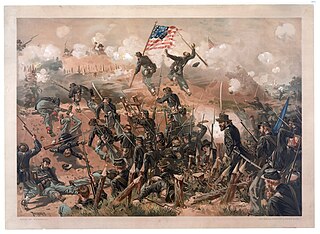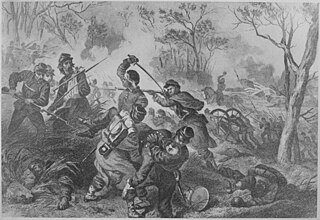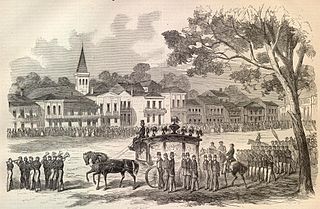
The siege of Vicksburg was the final major military action in the Vicksburg campaign of the American Civil War. In a series of maneuvers, Union Major General Ulysses S. Grant and his Army of the Tennessee crossed the Mississippi River and drove the Confederate Army of Mississippi, led by Lieutenant General John C. Pemberton, into the defensive lines surrounding the fortress city of Vicksburg, Mississippi, leading to the successful siege and Confederate surrender.

The siege of Port Hudson was the final engagement in the Union campaign to recapture the Mississippi River in the American Civil War. While Union General Ulysses Grant was besieging Vicksburg upriver, General Nathaniel Banks was ordered to capture the lower Mississippi Confederate stronghold of Port Hudson, Louisiana, to go to Grant's aid. When his assault failed, Banks settled into a 48-day siege, the longest in US military history up to that point. A second attack also failed, and it was only after the fall of Vicksburg that the Confederate commander, General Franklin Gardner, surrendered the port. The Union gained control of the river and navigation from the Gulf of Mexico through the Deep South and to the river's upper reaches.

The Battle of Port Gibson was fought between a Union Army commanded by Major General Ulysses S. Grant and a reinforced Confederate States Army division led by Major General John S. Bowen. Though the outnumbered Confederate soldiers fought stubbornly, they were steadily pressed back during the day by Major General John A. McClernand's troops. Bowen eventually conceded the field by withdrawing north toward Vicksburg, Mississippi. The battle occurred near Port Gibson, Mississippi, during the Vicksburg Campaign of the American Civil War.

The Battle of Baton Rouge was a ground and naval battle in the American Civil War fought in East Baton Rouge Parish, Louisiana, on August 5, 1862. The Union victory halted Confederate attempts to recapture the capital city of Louisiana.

Daniel Ruggles was a Brigadier General in the Confederate States Army during the American Civil War. He was a division commander at the Battle of Shiloh.

André Cailloux was an African American army captain, one of the first black officers of any North American military unit. He was also one of the first black soldiers to die in combat during the American Civil War. He was killed during the unsuccessful first attack on the Confederate fortifications during the Siege of Port Hudson. Accounts of his heroism were widely reported in the press, and became a rallying cry for the recruitment of African Americans into the Union Army.

Franklin Kitchell Gardner was a Confederate major general in the American Civil War, noted for his service at the Siege of Port Hudson on the Mississippi River. Gardner built extensive fortifications at this important garrison, 16,000 strong at its peak. At the mercy of conflicting orders, he found himself besieged and greatly outnumbered. His achievement at holding out for 47 days and inflicting severe losses on the enemy before surrendering has been praised by military historians.
The Port Hudson State Historic Site is located on the Mississippi River north of Baton Rouge in East Feliciana Parish, Louisiana, just outside the limits of Port Hudson and in the vicinity of Jackson. The site preserves a portion of the fortifications and battle area of the longest siege in American history, during the American Civil War from May 23 through July 9, 1863. The state of Louisiana maintains the site, which includes a museum about the siege, artillery displays, redoubts, and interpretive plaques. Historical reenactments are held each year. It was designated a National Historic Landmark in 1974, significant as the first place where African-American military units fought for the Union Army under African-American field leadership.
The Pointe Coupee Artillery was a Confederate Louisiana artillery unit in the American Civil War made up primarily of men from the parishes of Pointe Coupee, East Baton Rouge, Livingston and other surrounding parishes as well as a large number of men from New Orleans.
The Battle of Richmond was fought on June 15, 1863, near Richmond, Louisiana, during the Vicksburg campaign of the American Civil War. Major General John George Walker's division of Confederate troops, known as Walker's Greyhounds had attacked Union forces in the Battle of Milliken's Bend and the Battle of Lake Providence earlier that month in hopes of relieving some of the pressure on the Confederate troops besieged in Vicksburg, Mississippi. While both of Walker's strikes were failures and the Confederates withdrew to Richmond, Union Major General Ulysses S. Grant still viewed the presence of Walker's men at Richmond to be a threat. On June 14, the Mississippi Marine Brigade and the infantry brigade of Brigadier General Joseph A. Mower were sent to attack the Confederates at Richmond.

The Battle of Lake Providence was fought on June 9, 1863, during the Vicksburg campaign of the American Civil War. Confederate troops from the Trans-Mississippi Department were trying to relieve Union pressure during the Siege of Vicksburg. Major General Richard Taylor, primarily using Walker's Greyhounds, prepared a three-pronged attack against Union positions at Milliken's Bend, Young's Point, and Lake Providence, which was scheduled to take place on June 7. The strike against Lake Providence was conducted by 900 men led by Colonel Frank Bartlett.

Miles' Legion was a unit of the Confederate Army during the American Civil War. It was commanded by Colonel William R. Miles. The unit was officially named the 32nd Louisiana Infantry Regiment but it was never referred to by that name. The legion fought at the Battle of Plains Store and the Siege of Port Hudson. Captured at Port Hudson, the men were paroled, and the legion was declared exchanged in fall 1863. Many of the exchanged men never returned to duty. Those who did return joined Gober's Mounted Infantry Regiment or the 15th Louisiana Sharpshooter Battalion.

The 48th Regiment Massachusetts Volunteer Infantry was a regiment of infantry that served in the Union Army during the American Civil War. It was one of the 18 Massachusetts regiments formed in response to President Abraham Lincoln's August 1862 call for 300,000 men to serve for nine months. It consisted of a combination of Essex County companies and Irish-American companies which caused some delay and friction during the unit's formation. The regiment was assigned to the Department of the Gulf and saw heavy combat during the Siege of Port Hudson.

The 49th Regiment Massachusetts Volunteer Infantry was a regiment of infantry that served in the Union Army during the American Civil War. It was one of the 18 Massachusetts regiments formed in response to President Abraham Lincoln's August 1862 call for 300,000 men to serve for nine months. The regiment was recruited in Berkshire County and rendezvoused for mustering in at Camp Briggs in Pittsfield, Massachusetts. William F. Bartlett, a veteran of the 20th Massachusetts was voted colonel in command of the regiment. The 49th Massachusetts was assigned to the Department of the Gulf and saw heavy combat during the Siege of Port Hudson.

The 50th Regiment Massachusetts Volunteer Infantry was a regiment of infantry that served in the Union Army during the American Civil War. It was one of the 18 Massachusetts regiments formed in response to President Abraham Lincoln's August 1862 call for 300,000 men to serve for nine months. The regiment was recruited in Essex County and rendezvoused for mustering in at Camp Edwin M. Stanton in Boxford, Massachusetts. The 50th Massachusetts was assigned to the Department of the Gulf under Major General Nathaniel P. Banks and shipped for Louisiana. The regiment saw combat during the Siege of Port Hudson.

The 52nd Regiment Massachusetts Volunteer Infantry was a regiment of infantry that served in the Union Army during the American Civil War. It was one of the 18 Massachusetts regiments formed in response to President Abraham Lincoln's August 1862 call for 300,000 men to serve for nine months. The regiment was recruited in Franklin and Hampshire Counties and rendezvoused for mustering in at Camp Miller in Greenfield, Massachusetts. The 52nd Massachusetts was assigned to the Department of the Gulf under Major General Nathaniel P. Banks and shipped for Louisiana. The regiment participated in the Bayou Teche campaign in western Louisiana during April and May 1863 and then saw combat during the Siege of Port Hudson.

The 6th Massachusetts Battery was an artillery battery that served in the Union Army during the American Civil War. The unit was one of the Massachusetts regiments organized in response to President Abraham Lincoln's call on May 2, 1861 for volunteer troops to serve a term of three-years. The battery trained at Camp Chase in Lowell, Massachusetts. It was assigned to the Department of the Gulf under Major General Benjamin F. Butler and departed Boston by steamship on February 8, 1862. At that time, the unit comprised 145 men armed with two rifled and four smoothbore six-pounder field guns.

The 2nd Louisiana Field Battery was an artillery unit recruited from volunteers in Louisiana that fought in the Confederate States Army during the American Civil War. The battery organized on 1 March 1862 at Red River Landing, Louisiana as Company B, of Miles' Legion Artillery. However, the battery usually served independently from Miles' Legion. In 1863, the battery fought at Plains Store and Port Hudson and was captured when the latter place surrendered in July 1863. After a prisoner exchange, the battery reorganized in December 1863. The unit fought at Mansura in May 1864 using two large caliber Parrott rifles captured from Union vessels. In an action at Simmesport in June, one gun was captured and the other gun burst. The last soldiers in the battery received their paroles in early June 1865.

The 18th Independent Battery New York Light Artillery was an artillery battery that served in the Union Army during the American Civil War. The unit was organized in September 1862 and shipped to New Orleans. The battery fought at Fort Bisland, Vermilion Bayou, Plains Store, and Port Hudson in 1863. The battery served in garrison until 1865 when it fought at Spanish Fort and Fort Blakeley. It was mustered out of federal service in July 1865.

The 1st Mississippi Light Artillery Regiment was a unit of the Confederate States Army from Mississippi. Formed in 1862, the regiment was sent to defend the strategic points of Vicksburg and Port Hudson along the Mississippi River. After the surrender of Confederate forces at Vicksburg on July 4, 1863, the various companies of the 1st Light Artillery were dispersed and saw action across the Western theater of the American Civil War, although they never operated as a combined regiment. The final remnants of these artillery batteries surrendered in April 1865 after the Battle of Fort Blakeley.













